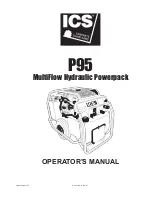
9
Jig saw
Intended Use
The machine is intended for making separating cuts and
cutouts in wood, plastic, metal, ceramic plates and rub-
ber while resting firmly on the workpiece. It is suitable for
straight and curved cuts with mitre angles to 45°. The saw
blade recommendations are to be observed.
Technical specifications (fig. 1)
Product elements (fig. 2)
1. Switch for on/off
2. Button for switch locking
3. Wheel for adjusting sawing speed
4. Lever for selecting sawing mode
GENERAL POWER TOOL SAFETY WARNINGS
Read all safety warnings and all instructions.
Failure to follow the warnings and instructions may result
in electric shock, fire and/or serious injury.
Save all warnings and instructions for future reference.
The term “power tool” in the warnings refers to your main-
soperated (corded) power tool or battery-operated (cord-
less) power tool.
Work area safety
• Keep work area clean and well lit. Cluttered or dark areas
invite accidents.
• Do not operate power tools in explosive atmospheres,
such as in the presence of flammable liquids, gases or
dust. Power tools create sparks which may ignite the
dust or fumes.
• Keep children and bystanders away while operating a
power tool. Distractions can cause you to lose control.
Electrical safety
• Power tool plugs must match the outlet. Never modify
the plug in any way. Do not use any adapter plugs with
earthed (grounded) power tools. Unmodified plugs and
matching outlets will reduce risk of electric shock.
• Avoid body contact with earthed or grounded surfaces,
such as pipes, radiators, ranges and refrigerators. There
is an increased risk of electric shock if your body is
earthed or grounded.
• Do not expose power tools to rain or wet conditions.
Water entering a power tool will increase the risk of
electric shock.
• Do not abuse the cord. Never use the cord for carrying,
pulling or unplugging the power tool. Keep cord away
from heat, oil, sharp edges and moving parts. Damaged
or entangled cords increase the risk of electric shock.
• When operating a power tool outdoors, use an
extension cord suitable for outdoor use. Use of a cord
suitable for outdoor use reduces the risk of electric
shock.
• If operating a power tool in a damp location is unavoid-
able, use a residual current device (RCD) protected sup-
ply. Use of an RCD reduces the risk of electric shock.
Personal safety
• Stay alert, watch what you are doing and use common
sense when operating a power tool. Do not use a power
tool while you are tired or under the influence of drugs,
alcohol or medication. A moment of inattention while
operating power tools may result in serious personal
injury.
• Use personal protective equipment. Always wear eye
protection. Protective equipment such as dust mask,
non-skid safety shoes, hard hat, or hearing protection
used for appropriate conditions will reduce personal
injuries.
• Prevent unintentional starting. Ensure the switch is in
the off-position before connecting to power source and/
or battery pack, picking up or carrying the tool. Carrying
power tools with your finger on the switch or energising
power tools that have the switch on invites accidents.
• Remove any adjusting key or wrench before turning the
power tool on. A wrench or a key left attached to a rotat-
ing part of the power tool may result in personal injury.
• Do not overreach. Keep proper footing and balance at
all times. This enables better control of the power tool in
unexpected situations.
• Dress properly. Do not wear loose clothing or jewellery.
Keep your hair, clothing and gloves away from mov-
ing parts. Loose clothes, jewellery or long hair can be
caught in moving parts.
• If devices are provided for the connection of dust extrac-
tion and collection facilities, ensure these are connected
and properly used. Use of dust collection can reduce
dust-related hazards.
Power tool use and care
• Do not force the power tool. Use the correct power
tool for your application. The correct power tool will
do the job better and safer at the rate for which it was
designed.
• Do not use the power tool if the switch does not turn
it on and off. Any power tool that cannot be controlled
with the switch is dangerous and must be repaired.
• Disconnect the plug from the power source and/or the
battery pack from the power tool before making any
adjustments, changing accessories, or storing power
tools. Such preventive safety measures reduce the risk of
starting the power tool accidentally.
• Store idle power tools out of the reach of children and
do not allow persons unfamiliar with the power tool
or these instructions to operate the power tool. Power
tools are dangerous in the hands of untrained users.
• Maintain power tools. Check for misalignment or bind-
ing of moving parts, breakage of parts and any other
condition that may affect the power tool’s operation.
If damaged, have the power tool repaired before use.
Many accidents are caused by poorly maintained power
tools.
• Keep cutting tools sharp and clean. Properly maintained
cutting tools with sharp cutting edges are less likely to
bind and are easier to control.
English
Summary of Contents for 91271129
Page 2: ...2 ...
Page 3: ...3 220 240 V 50 60 Hz 710 W 1 99 kg 80 mm 8 mm 0 3000 min 1 4 TEST ...
Page 4: ...4 7 5 6 5 8 8 ...
Page 5: ...5 1 2 3 0 2 3 1 0 3 1 0 2 10 9 1 2 3 3 4 5 4 5 6 ...
Page 19: ...19 Exploded view 12 13 18 19 22 7 5 3A 2A 29A 30 28A 32 31A 61 ...
Page 21: ...21 RU FR DE GB Garantiebedingungen Warranty terms Conditions de garantie Условия гарантии ...
Page 28: ...28 ...
Page 29: ...29 ...
Page 32: ...32 ...
Page 34: ...34 ...
Page 35: ...35 ...










































